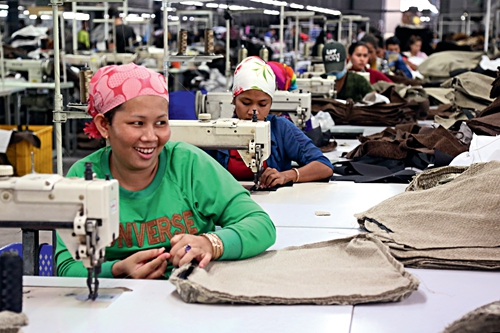Capacity cooperation promoted through ‘ASEAN Plus Three’

A woman works at a sofa factory in the Sihanoukville Special Economic Zone in Cambodia. Jointly established by companies from Cambodia and China, the economic zone is an example of production capacity cooperation between China and ASEAN countries.
The International Symposium on “ASEAN Plus Three” Industrial Capacity Cooperation was held on Feb. 25 in Shenzhen.
Themed “Promote Industrial Capacity Cooperation to Achieve Shared Development,” the symposium provides an opportunity for scholars from China and abroad to brainstorm on production capacity cooperation among the countries within the “ASEAN Plus Three” (APT) framework.
Significant achievements have been made in the three years since the “Belt and Road” initiative was proposed, said Zhang Jiang, vice-president of CASS. Connectivity and international production capacity are two of the major domains of the initiative, and promoting international production capacity cooperation will be a new source of momentum, Zhang said.
The APT is one of the most populated, multicultural and dynamic regions in the world. The APT framework has become a major platform for cooperation among East Asian and Southeast Asian countries. Cooperation offers an opportunity for countries in the region to participate in the global value chain, contributing to local prosperity, said Bui Nhat Quang, vice-president of the Vietnam Academy of Social Sciences.
The APT mechanism, established by the ASEAN members along with China, Japan and the Republic of Korea (ROK), has set up 66 dialogue mechanisms at all levels, covering 24 fields in the past two decades. It has contributed significantly to the peace, stability and development of Asia as well as regional cooperation and integration, Bui stated.
Du Peng, director of the Administration Bureau of the Qianhai Shenzhen-Hong Kong Modern Service Industry Cooperation Zone in the Shenzhen Special Economic Zone, said China initiated capacity cooperation within the APT. China’s advantage in production capacity and equipment should be combined with Japan and ROK’s capacity in research and development, satisfying the needs for urbanization and industrialization in all ASEAN member countries, Du added.
It will inject new momentum into the economic development of ASEAN countries; provide a new platform for the economic integration of China, Japan and ROK, and create new opportunities for cooperation and mutual benefit among companies in these countries, Du remarked.
Yang Mu, the executive director of the Institute of Public Policy at the South China University of Technology, said for countries that are smaller in terms of territory, such as Vietnam and Cambodia, external support in markets and resources is particularly necessary for industrialization. China has proposed strengthening production capacity cooperation with the goal of establishing a more integrated regional and global value. Only by participating in this process, can the countries with a low level of industrialization become highly industrialized, he said.
In regard to how China can further promote international production capacity cooperation, Sun Xuegong, a research fellow from the Academy of Macroeconomic Research under the National Development and Reform Commission of China, said China should adhere to the principle of green and sustainable development when participating in international production capacity cooperation. Policies guiding China’s cooperation should give sufficient consideration to the local environmental carrying capacity where the projects were to be carried out, and sustainable development of local countries cannot be ignored, he added.
The symposium was organized by the National Institute of International Strategy at the Chinese Academy of Social Sciences (CASS).
LI YONGJIE is a reporter at the Chinese Social Sceicnes Today.
